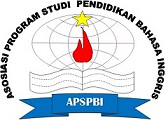INCORPORATING EXTENSIVE READING INTO THE CURRICULUM OF ENGLISH TEACHER EDUCATION
Abstract
Keywords
Full Text:
PDFReferences
Antoro, B. (2017). Gerakan Literasi Sekolah, Dari Pucuk Hingga Akar : Sebuah Refleksi. Kementerian Pendidikan dan Kebudayaan.
Creswell, J. W. (2012). Educational Research: Planning, Conducting, and Evaluating Quantitative and Qualitative Research. Pearson.
Creswell, J. W., & Creswell, J. D. (2018). Research Design: Qualitative, Quantitative, and Mixed Methods Approaches. In SAGE Publications, Inc. (5th edition). SAGE Publications, Inc. https://doi.org/10.1128/AAC.03728-14
Day, Richard. (2015). Extending Extensive Reading. Reading in a Foreign Language, 27(2), 294–301.
Day, Richard. (2018). Extensive Reading. The TESOL Encyclopedia of English Language Teaching, 1–7. https://doi.org/10.1002/9781118784235.eelt0472
Day, Richard, & Bamford, J. (2002). Top Ten Principles for Teaching Extensive Reading. Reading in a Foreign Language, 14(2), 136–141.
Day, RR, & Bamford, J. (1998). Extensive Reading in the Second Language Classroom. Cambridge University Press.
Dowling, P., & Brown, A. (2010). Doing Research/Reading Research: Reinterrogating Education. Routledge.
ER Foundation. (2019). Extensive Reading Guide. www.erfoundation.org
Ewert, D. (2017). Getting ER into the Curriculum: No More Excuses! CATESOL Journal, 29(2), 5–20. http://proxy.libraries.smu.edu/login?url=http://search.ebscohost.com/login.aspx?direct=true&db=eric&AN=EJ1164371&site=ehost-live&scope=site
Green, C. (2005). Integrating extensive reading in the task-based curriculum. ELT Journal, 59(4), 306–311. https://doi.org/10.1093/elt/cci059
Iftanti, E. (2012). A Survey of the English Reading Habits of EFL Students in Indonesia. TEFLIN Journal, 23(2), 149–164. https://doi.org/10.15639/teflinjournal.v23i2/149-164
Macalister, J. (2008). Implementing extensive reading in an EAP programme. ELT Journal, 62(3), 248–256. https://doi.org/10.1093/elt/ccm021
Macalister, J. (2010). Investigating teacher attitudes to extensive reading practices in higher education: Why isn’t everyone doing it? RELC Journal, 41(1), 59–75. https://doi.org/10.1177/0033688210362609
Mo, J. (2019). PISA 2018 Assessment and Analytical Framework.
Ng, Q. R., Renandya, W. A., & Chong, M. Y. C. (2019). Extensive reading: Theory, research and implementation. Teflin Journal, 30(2), 171–186. https://doi.org/10.15639/teflinjournal.v30i2/171-186
Nugrahanto, S., & Zuchdi, D. (2019). Indonesia PISA Result and Impact on The Reading Learning Program in Indonesia. 373–377. http://puspendik.kemdikbud.go.id/inap-
Odo, D. M. (2018). Pre-service English Teachers’ Extensive Reading and Its Effect on L2 Reading Self-efficacy. Language Research, 54(2), 331–356. https://doi.org/10.30961/lr.2018.54.2.331
Renandya, W. (2017). Current Practice of Extensive Reading in Asia: Teachers’ Perceptions. Reading Matrix: An International Online Journal, 17(1), 40–58.
Robson, C. (2011). Real World Research. A Resources for Users of Social Research Methods in Applied Settings. Wiley.
Salikin, H., Bin-Tahir, S. Z., Kusumaningputri, R., & Yuliandari, D. P. (2017). The Indonesian EFL Learners’ Motivation in Reading. English Language Teaching, 10(5), 81. https://doi.org/10.5539/elt.v10n5p81
Stein, K. (2018). Extensive reading in theory and in practice. Modernenglishteacher, 24(1), 52–54.
Stoller, F. L. (2015). Viewing extensive reading from different vantage points. Reading in a Foreign Language, 27(1), 152–159.
Syahril, I. (2019). The New Generation of High Quality ESL/EFL TEACHERS: A Proposal for Interdisciplinary Teacher Education. A Journal on Language and Language Teaching, 22(1), 33–45.
Xiaomei, S. (2020). Teachers’ Roles in Implementing Extensive Reading. ELTED, 23, 1–9.
DOI: http://dx.doi.org/10.20527/jetall.v5i2.12872
Article Metrics
Abstract view : 405 timesPDF - 349 times
Refbacks
- There are currently no refbacks.
This journal is indexed in:


This Journal is listed in:
 Journal of English Teaching, Applied Linguistics and Literatures (JETALL)
Journal of English Teaching, Applied Linguistics and Literatures (JETALL)








.png)



1.png)
